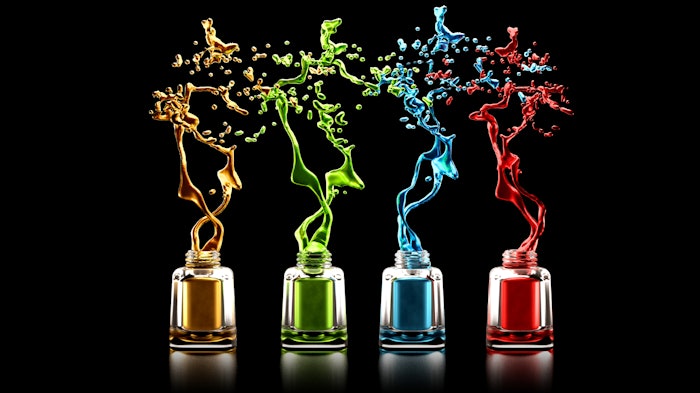
By Vivian Valenty, Ph.D.
Thousands of years ago, women and men began decorating their nails not only for beauty but as a class distinction. The earliest instance of colored nails was in 3200 B.C. when males in Babylon dyed their nails with kohl before going into battle. During 3000 B.C., the Chinese and Egyptians used beeswax, egg whites, gelatin, natural gums and flowers to make nail colors. Around 600 B.C., the lower class in China was sentenced to death for wearing nail polish, while the royal echelons preferred metallic, gold and silver. Henna was used in Egypt, as evidenced by the mummified pharaohs. The use of henna may have started in India during the Bronze Age before the Chinese improved upon it to achieve limited color choices.
When the automobile industry used pigments of various colors suspended in a solvent-borne coating during the 20th century, the polish of the old autocracy evolved to become nail polishes requiring an hour or more to dry which then chipped after a few days. We will refer to these compositions as "traditional nail polish' consisting of:
- A film-forming polymer called nitrocellulose, a member of the gun cotton family.
- Volatile organic solvents such as butyl acetate, ethyl acetate, and toluene. Most companies have now reformulated out toluene in their products.
- Plasticizers to prevent the film former from becoming brittle such as tributyl citrate, camphor, DBP, and TPHP. Most companies have replaced the last three.
- Resins to modify the properties of the nitrocellulose such as tosylamide/formaldehyde and tosylamide/epoxy resins.
- Pigments: the U.S. FDA approves only colorants that are FDC-certified.
- Thickening agents to keep the pigments suspended, of which the most common are modified clays such as stearalkonium hectorite and stearalkonium bentonite.
- Ultraviolet (UV) stabilizers to delay the bleaching of the colors in sunlight. Benzophenone-1 is the most common.
Modern nail professionals routinely apply traditional nail polish over a base coat and then finish with a top coat. The purpose of the base coat is to improve the adhesion of the polish to the nail surface and prevent its pigments from staining the natural nail. The top coat is then applied over the nail polish to create a glossier finish while resisting abrasion.
Before the 1960s, traditional nail polishes were only applied directly to bare nails, and convention clearly defined that all manicures and pedicures were services intended for natural nails. Women loved the availability of numerous colors and their fancy names but wished for instant long nails and fast-drying, long-wearing polish on natural nails.
Product developers delivered on these desires with the advent of new technologies. It all began in 1954, when Dr. Fred Slack, a dentist, broke his fingernail and mended it using dental materials. Other companies ultimately advanced his invention, which became known as artificial nails or acrylic nail enhancements. Acrylic nail enhancements provided instantly long nails and solved the premature chipping issues of traditional nail polish because the acrylic surface provided a uniform composition resulting in a predictable adhesion.
In 1982, UV lamps were first used in nail services with the introduction of hard gels by James Giuliano. These high-viscosity liquid formulations are supplied in jars, brushed onto the natural nail, and hardened (or cured) when exposed to UV light. They're called hard gels because of their abrasion resistance, and once cured, the only way to remove them is by filing them off.
In 1990, I invented the first UV top coat. It was formulated to effectively dry freshly applied traditional nail polish when allowed to air-dry for three minutes, then exposed to UV light for three to four minutes.
Traditional nail polish was the only product available to impart color to acrylic, gel and natural nails until the 21st century.
The first long-wear polish was introduced in 2007. These products are like traditional nail polish; however, there is no curing involved, wears like gel polish (that came later) and is removed by wiping off with regular nail polish removers. Long-wear polish’s nonyellowing property uniquely stands out due to the absence of nitrocellulose. Unlike traditional polishes, which may take 60 minutes or more to dry, this long-wear polish air-dries fully in just five minutes and provides a seven-to-14-day chip-free wear like a gel.
Other modern innovations brought colored acrylics and UV gel polishes, introduced in 2009, and Shellac™ in 2010. UV gel polishes, supplied in a bottle with a brush, are modified UV hard gel with traditional polish in one formulation, resulting in a colored gel that can be removed by filing off or soaking the cured coating in pure acetone. Hybrids, introduced in 2013, cure in sunlight and have a higher ratio of polish components to gel, making them easier to remove than gel polishes.
Modern innovations also include dip systems, which like acrylics, are two-component liquid and powder systems that use the same removal methods but differ in curing chemistries. And finally, press-on nails and polish strips were introduced as solvent-free and instant-dry options.
All products described above are applied to natural nails, exposing the nail surface when the wearer removes the coating. They differ from each other by their permanency or degree of attachment to the natural nail.
What motivating factors led to these historic innovations within the nail polish industry?
- Convenience
- Time savings
- Longevity of wear
- Wellness awareness
Currently, trending innovations include “manicure robots” in response to a shortage of professional nail technicians. Of course, no machine will ever replicate our many human innovators and artists' pure passion, vision or talents. Those who have forged this illustrious history for centuries will pass on the legacy for generations to come. Our future is bright.
Chronology in detail can be found at beautytrainingstudio.co.uk/history-of-nails.











